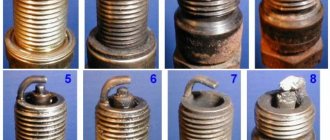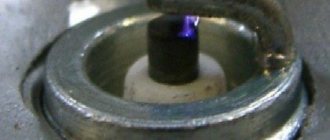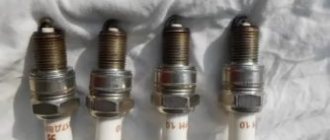Sooner or later, all motorists are faced with the next problem of replacing spark plugs. And those who are not accustomed to the services of auto mechanics and prefer to solve problems on their own very often witness the formation of dirt on the spark plugs. Yellow deposits on the spark plug insulator or brown deposits on spark plugs occur for certain reasons and are often of different natures. In this article, we will try to understand them, and also explain how to avoid such a fate in the future.
Why does carbon deposits appear on candles?
The optimal period for using spark plugs is considered to be 60,000 kilometers. Professional auto mechanics advise replacing the element immediately after crossing this milestone.
With regular care and inspection of the vehicle, it is not always possible to avoid the appearance of a light coating on the surface of the product. The normal color of the top tip is considered to be a light gray shade. The occurrence of slight changes does not affect the performance of vehicles.
- Experts identify several reasons that can provoke such changes.
- The spark plugs inside the engine are designed to act as the ignition element that creates the spark.
- It promotes combustion of the fuel mass. The design of the mechanism implies the location of these elements next to the combustion chamber of the engine.
- When the engine starts, the surface of the spark plug experiences enormous loads.
- In addition, they are exposed to increased pressure, high temperature and various physical and chemical processes.
As a result, after some time, a grayish deposit appears in the lower section of the spark plug, on the surface of the insulator or electrode. Foreign particles are evenly distributed over the surface of the metal tip.
Depending on the type of problem with the car engine, the color palette of the spark plug tip may vary. Red, orange and black spots may appear around the perimeter of the body.
Timely diagnostics will allow you to avoid serious problems in the vehicle’s performance. First of all, it is recommended to pay attention to the state of the ignition timing or ignition timing.
Causes of soot
The normal service life of spark plugs is 50 thousand km. Once this milestone is reached, they must be replaced. This is a normal result and cannot be avoided. An interesting fact: you can take excellent care of your car, but plaque will still appear. Their normal color is grey. Minor changes are not scary if the electrodes do not have visible damage. If plaque appears on new spark plugs, then you need to look for the reasons.
Which color is not dangerous?
The performance of a gasoline engine directly depends on the condition of the spark plug electrodes. Their surface should be painted in a dirty brown shade, without traces of oil and soot elements.
If the surface of the spark plug is changed, it is recommended to carry out unscheduled technical diagnostics to detect the cause of such problems. Various parts of a gasoline engine can provoke such changes.
There are several color options that cover spark electrodes. These include:
- Grey;
- White;
- Terracotta;
- Red;
- Black.
The top of the spark plug may be covered with various deposits. Most often it is subject to oil deposits or a thick layer of soot. Such changes indicate serious problems with the engine.
How does oil get into the spark plug well?
It’s very simple, in the hands of service station specialists or warranty service. It also happens that a part breaks through the thread. Especially when you often unscrew the spark plug, there is no 100% tightness.
After all, exhaust gases may still contain oil particles, and they end up in the well.
Valve cover seals can also leak; over time, they become tanned and begin to leak oil into the spark plug wells.
Just understand - half a drop is enough for it to then settle on the insulator with ionized air in the form of a brown coating.
This can also include dust, dirt, etc. All this also settles.
Of course, there are perfectly clean insulators even on 16 valve engines, but the point here is different
Types of carbon deposits on candles
We propose to consider several situations to help understand the cause of these changes. For example, the vehicle has traveled a distance of over 25 km.
When unscrewing the spark plugs, we discovered that a light gray or terracotta tint had appeared on the surface of the electrodes.
The surface of the metal tip is undeformed and there are no traces of oil deposits. Such changes indicate the normal performance of the car. Minor changes indicate proper combustion chamber operation.
Similar shades are not always found. Many motorists, after unscrewing the spark plugs, discovered that the surface acquired the following color:
- Black;
- White;
- Red.
In addition to tint, the tip may be covered with traces of gasoline, automobile oil, ash, or corrosion. When simply inspecting spark plugs, it is important to determine the structure of the deposit.
For example, if black matte soot appears, then this phenomenon indicates contamination in the air filter area, improper fixation of the spark gap, a crack in the insulator, or improper carburetor adjustment.
The situation can be corrected by correct adjustment of engine operating processes, setting the correct spark gap, and replacing the igniting mechanism.
Cleaning spark plugs - using proven methods
Timely cleaning of spark plugs allows you to extend their life and stabilize the operation of the ignition system and the engine as a whole. Several methods can be used to clean carbon deposits. The simplest and most convenient is cleaning at home using fine-grained sandpaper or a metal, nylon or even toothbrush. Carefully clean the contaminated surface with a brush, then sand with fine sandpaper. The most important thing is to try not to deeply scratch the surface and not to disturb the established gap between the electrodes, so do not use rough objects (screwdrivers, awls) for cleaning.
The second way to wash off the deposits that have formed is to use available household chemicals and various detergent compositions. Degrease the contaminated surface, then dip the candles in a solution with detergent and leave them for several hours; acetone, vinegar, and household chemicals are well suited for these purposes. To cleanse yellowish or red plaque, you can even use affordable products such as Cola or Sprite. They contain orthophosphoric acid, which facilitates easy cleansing. When using ammonium acetate or another acidic solution, you must first calcinate the candles and heat them to a high temperature, and then sharply lower them into the acid solution for several minutes.
High-quality cleaning of spark plugs can also be carried out in specialized car services. As a rule, they offer cleaning with special ultrasound or sandblasting.
Black carbon deposits on spark plugs
The occurrence of black soot is directly related to the contact of the metal tip and the air-fuel mixture. If before installation the surface was uniform or had a gray tint, then the appearance of a velvety black coating is directly related to the following reasons:
- Penetration of the oil mixture into the combustion chamber area;
- Low fuel quality;
- Multiple excesses of the permissible concentration of metal additives in gasoline;
- Malfunction of the cooling system;
- Problems with the ignition timing settings;
- Using low octane gasoline.
What to do if a dark-colored plaque appears? The first step is to familiarize yourself with the composition of the oil mixture and the condition of the piston rings. If the mixture is correctly selected, then you should pay attention to the fuel mixture.
After this, you can diagnose the cooling system and replace the spark plugs with new elements. When adjusting the ignition timing, it is recommended to pay attention to the recommendations of specialists. The fact is that an incorrect gap will provoke the occurrence of new faults.
Eliminating the causes of unsatisfactory operation of the ignition system
The main reason for insufficient combustion of fuel in the cylinder is an incorrectly prepared fuel mixture. In older model cars, the carburetor was responsible for the quality of the mixture. The device provided:
- enrichment of fuel with oxygen;
- oxygen dosing in fuel;
- exhaust gas recirculation;
- supplying the fuel mixture to the internal combustion engine cylinders.
The main adjustments to the fuel composition are the quality and quantity screws. The first determines the amount of oxygen in gasoline, the second the amount of gasoline. A spark plug covered with a white coating indicates that the carburetor is oversaturating the fuel with oxygen. In many cases, it is enough to turn the quality screw or adjust the throttle to fix the problem. But it may be necessary to replace the carburetor metering jet or clean it of contaminants. The jets are made of soft copper, so cleaning it without damaging it is not easy. Use soft wire or compressed air. The hole can be cleaned by soaking it in gasoline or other solvents for several hours.
The carburetor may also not be supplying enough oxygen to the fuel. The mixture does not burn completely and a black coating forms on the candles. The normal operation of the carburetor is restored by adjustment.
Carburetor VAZ 2107
The situation is somewhat different with cars equipped with a fuel supply system with injectors. The color of spark plug carbon reacts to the quality of the fuel mixture, just as in carburetor systems. But injectors in modern cars are regulated only using computer technology using specialized software. It is possible to diagnose a malfunction by the color of the spark plug, but it is unlikely that you will be able to establish the correct ignition angle and the ratio of the components of the combustible mixture yourself; this is the domain of service centers.
White carbon deposits on spark plugs
The appearance of a white tint on the surface of the spark plug electrodes indicates a poor-quality composition of the air-fuel mixture. It is not recommended to use such gasoline in the future. The fact is that components in the fluid can cause new problems with engine operation.
When starting the engine, a disturbed combustion process is observed, which is accompanied by a large release of thermal energy. As a result, the combustion chamber overheats, thereby causing the metal tips and metal edge to melt.
Other factors that indicate there is a problem
It's not just the color that can tell you that there are problems with the engine. For example, if you notice that erosion has formed on the electrodes, then most likely you are using low-quality gasoline, which has a high lead content. Poor clearance also contributes to erosion. Ash itself is an insulator; therefore, if its layer is too thick, then the required voltage will not be able to develop in the system. The appearance of ash is facilitated by the fact that the engine fluid does not burn completely in the engine cylinders, which is due to other problems associated with the piston rings.
As for motor fluid residues on the electrodes, they indicate failure of the valves or partitions; metal shavings may also be located on the electrodes.
In this case, the system is again filled with gasoline, which is why this happens:
- the system as a whole is not working properly;
- There were problems with the ignition.
If the vehicle is stationary for a long time, at the beginning of its operation the internal combustion engine may experience tripping, which disappears over time. In this case, blue-white smoke will come out of the muffler. In this case, the problem most likely lies in the cylinder temperature. Oil forms on the spark plugs when the spark plug itself is cold, or when there is a need to replace the oil caps or piston rings.
If the problem is not resolved in a timely manner, fuel consumption may double, and if the malfunction is related to the piston rings or partitions, then it will have to be solved in any case. And it’s better not to delay this moment!
Red carbon deposits on spark plugs
Redness of the tips on the spark plug appears when low-quality fuel is used. Some manufacturers resort to using chemical additives made from metal components to increase the octane number.
In general, the majority of the compounds are lead. When burned, the additives begin to quickly oxidize and uniformly cover the surface of the electrical contact with an orange or red coating.
- As a result, a disturbance in the sparking process is observed. In most cases, the engine may not start the first time.
- Additives in gasoline have a negative impact on other engine components.
It is recommended to change the fuel and carry out thorough diagnostics in the power plant area. Specialized equipment will allow you to accurately detect the source of the problem and select methods to eliminate it.
Soot color - what does it mean and what to do?
Take a close look at the spark plugs. Their color will help you understand a lot... For example, you will be able to identify problem areas of the car. It is not enough to just replace the problematic element; look deeper and look for the cause. If it is not corrected, the new spark plug will very quickly become unusable. The problem needs to be cut to the root. The first step is to deal with the ignition system. The next step is to look at the candles. Determine what color the resulting plaque is. Highlight:
- black
- red
- white
Each of them indicates the presence of one or another problem.
Black soot
This type of soot occurs for a number of reasons. There are two subspecies:
- Dry;
- Oily.
Black and dry carbon deposits are applied to the spark plug due to an overly enriched mixture. This could have been preceded by:
- Incorrect carburetor operation;
- Air filter clogged;
- High pressure in the fuel rail;
- Little spark energy;
- Weak compression.
If an oily deposit appears, check that the oil does not get into the combustible mixture. Often the reason is trivial - wear of the oil scraper piston rings. Damage to the valve caps can also affect this.
White plaque
This color appears due to a number of reasons. White deposits on spark plugs can have several shades. Slightly ashy appears when the engine runs on low-quality gasoline. To overcome the problem, remove them, wipe them and they are usable again. Well, monitor the quality of gasoline. But the appearance of shiny soot and erosion on the contact electrodes is a sign of the use of overheated spark plugs. This happens due to an unenriched combustible mixture, early ignition, or a malfunction of the cooling system. Overheating is very dangerous for spark plugs, because it leads to cracks and various types of damage. Most often, this situation requires replacement.
Red and brown soot
As for red (sometimes called brown) soot, its appearance indicates the presence of unnecessary components in the fuel. It is also possible that too many additives have been added to the oil. A color like red brick may also appear if the engine has been running on leaded gasoline for a long time. The surface of the insulator is covered with a brown conductive coating, which disrupts the normal formation of sparks.
Fixing the problem is quite simple - clean the system.
The spark plug does not produce a spark if carbon deposits close the gap between the electrodes. This is a standard situation for cars in which the engine is subjected to high loads for a long time. To solve the problem, replace the spark plugs.
Photo instructions for diagnosing spark plugs
Frequency of replacement of spark plugs and main causes of plaque
Spark plugs vary in type and destination; in the automotive industry, spark plugs are widely used, the lifespan of which is determined by the type of engine, the type of fuel for the engine and the recommendations of the manufacturer of both the car and the spark plugs. Spark plugs for engines running on reduced natural gas last no more than 10,000 km, while spark plugs for diesel engines should be replaced after 12,000 km, and for gasoline power units after 15-16,000 km, that is, every maintenance.
If problems arise with the engine, the first thing to do is to diagnose the spark plugs, because In 85% of cases, they are the most common cause of vibrations when driving and when the car slightly pulls to the side. You can diagnose the spark plugs yourself using the instructions for replacing spark plugs. By pulling out one of the spark plugs, you can determine by the plaque the type of problem existing in the car system, which is why the spark plug is unable to work properly. The following types of layering on candles are distinguished by color:
The color of soot is the color of the burnt impurity contained in the fuel. Ideally, natural impurities in good fuel are practically not deposited on the spark plugs, except perhaps in the form of light salt deposits, giving a slightly grayish color. It is worth noting that problems in the engine are determined not only by color, but also by the structure and density of carbon deposits (plaque).
conclusions
There are many reasons why black soot may appear on the spark plugs of a VAZ-2114 engine, the main thing is to notice all the malfunctions in time and prevent them in time, which is not difficult.
By following a number of rules, you can avoid the appearance of black soot.
To avoid such problems, follow these rules:
- Keep the air filter clean.
- Make sure the engine is set correctly.
- Do not neglect the timely replacement of components of the cylinder-piston system.
- Keep the pressure stable.
By following these simple rules, you can avoid and even prevent the presence of soot on candles, and forget about its existence forever.
How to correctly assess the condition of spark plugs
Plaque on spark plugs, which forms during operation of a car, can provide fairly accurate information, but the test must be carried out in compliance with a number of rules:
- You can evaluate the plaque only after a run of 150–200 km, always with new or well-cleaned SZ.
- Don’t panic if, during the cold season, you hear slight interruptions in the engine’s operation, and at low speeds the ignition elements become covered with a black coating. This is the result of the fact that at low temperatures the working mixture undergoes mandatory enrichment, which, if the engine is slightly warmed up, will not be able to burn completely. If there are repeated interruptions in the operation of the motor, it is worth paying special attention to the condition of the high-voltage wires.
- When visually diagnosing elements, it is worth remembering that they can self-clean only at high temperatures, which are only possible when the engine is running at high speeds.
Cleaning the ignition elements
Spark plugs do not always require immediate replacement; sometimes they can simply be cleaned and the possible cause of deposits can be eliminated. This procedure can be carried out in two ways:
- Mechanical cleaning method. It consists of using simple sandpaper or a small wire brush. Despite the simplicity of the method, it has a number of disadvantages. With such cleaning, the coating on the SZ electrodes can be damaged, and simple scratches can cause increased accumulation of deposits.
- Chemical method. It is more preferable, especially for removing black deposits. The car enthusiast will need to prepare simple cleaning products, a toothbrush and a rag. The elements need to be soaked for about half an hour and then rinsed well. After drying, the candles can be used again.











